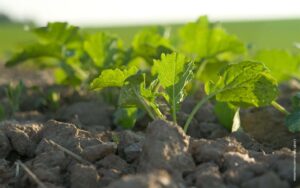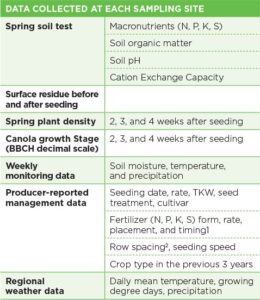Cultivar the major management factor for canola emergence rate
Key result:
Cultivar choice is the most influential factor for canola emergence percentage, this study found. Seeding date also influenced emergence, but this was mainly a function of environmental conditions. All environmental variables influenced emergence, and temperature and heat units were consistently more influential than precipitation and moisture.
Studies have shown that seeding speed and depth, seeding date, seed size, row spacing, crop rotation, and stubble management will influence canola establishment, but results of these studies are inconsistent across Western Canada where environmental conditions are variable and can be significantly yield-limiting. This observational on-farm study was conducted to improve our understanding of the interactive effects of management and environment on canola stand establishment.
This study was conducted on commercial canola fields in collaboration with six local producers around Indian Head, Saskatchewan, from 2018-20.
Environmental and agronomic data (see the table) were collected from several fields throughout the growing season and the producers provided their individual crop management data. Researchers used modelling to examine the additive and interactive effects of management and environment on the speed, temporal uniformity, and spatial uniformity of canola emergence.

Cultivar and soil temperature key for emergence rate
The top-ranking model, which weighted significantly higher than other models, showed an 80 per cent probability that “cultivar” and “average soil temperature 14 days after seeding” were the most influential management and environmental variables on canola emergence rate. The top-weighted model also had a significant interaction between cultivar and soil temperature, indicating that cultivars’ emergence rates were differentially affected by soil temperature.
Project title, Principal investigator:
“An on-farm approach to monitor and evaluate the interaction of management and environment on canola stand establishment”
Christiane Catellier, Indian Head Agricultural Research Foundation
Funding:
SaskCanola
Cultivar and soil temperature key for early season vigour
The top-ranking model showed a 99 per cent probability that cultivar and average soil temperature 21 days after the seeding were the most influential management and environment variables on canola growth rate. The top-ranked model again included a significant interaction between cultivar and soil temperature.
Higher air temperature, soil temperature, and heat units before and after seeding were associated with earlier emergence and higher early growth rates. Greater precipitation before seeding was associated with a faster growth rate, while higher soil moisture was associated with a delayed start and slower growth rate.
No clear major influence on spatial uniformity
Model weights were lower overall when competing models were compared, indicating that the prediction of spatial uniformity was more uncertain than emergence rate or growth rate, and that the variables measured were more equal in their influence on spatial uniformity. Environmental variables were more influential than management variables overall.
In summary, this study identified canola cultivar and post-seeding date temperature as the two most influential management variables that consistently impacted emergence response variables. Seeding date was also consistently and significantly influential on emergence, however the effect was not additive when combined with environmental variables, indicating that the effect of seeding date was mainly a function of environmental conditions. Temperature and heat units were consistently more influential on emergence than precipitation and moisture.
Overall, the study was valuable in demonstrating the potential of on-farm observational studies in agronomic research. Future expansion of this observational study to different agricultural production regions would benefit producers.

2 Producer-reported row width was used to calculate plant density but was not included in the analysis.





